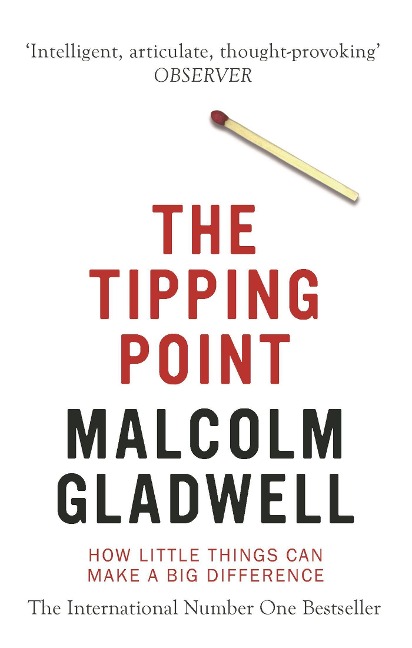The Tipping Point is a book by Malcolm Gladwell that explores the concept of how small changes or actions can have a significant impact on society. Gladwell argues that social epidemics are spread through three key players: the “Law of the Few“, “Stickiness Factor“, and “Power of Context“.
Law of the Few
The social epidemics are spread through the efforts of a small number of individuals, who he refers to as “Connectors”, “Mavens”, and “Salesmen.” These individuals play a disproportionate role in spreading ideas and information to a large group of people.
“Connectors” are people who have a wide social network and are able to bring people together. They are naturally gifted at connecting people and are able to create bridges between different social groups.
“Mavens” are individuals who have a wealth of information about a particular topic and are eager to share it with others. They are often seen as experts and are relied upon for advice and information.
“Salesmen” are individuals with charismatic personalities who are able to persuade and influence others. They are skilled at making a case for a particular idea or product and are often successful at selling it to others.
According to Gladwell, these three types of individuals play a crucial role in spreading ideas and information, and are the key drivers of social epidemics. The “Law of the Few” states that a small number of individuals are responsible for the majority of the spread of ideas and information, and that these individuals have a disproportionate impact on society.
Gladwell’s concept of the “Law of the Few” challenges the traditional notion that ideas spread based on their inherent quality or appeal, and instead suggests that the spread of ideas is largely driven by the efforts of a few key individuals. This idea has significant implications for marketers, policymakers, and anyone looking to create social change.

Stickiness Factor
The “Stickiness Factor” refers to the quality of an idea that makes it memorable and effective in spreading. Gladwell argues that for an idea to spread and become a social epidemic, it must be “sticky”, or memorable in such a way that it sticks in the minds of those who encounter it.
Gladwell provides several examples of “sticky” ideas, such as the children’s television show “Blue’s Clues” and the public health campaign to reduce the spread of AIDS. He argues that these ideas are memorable because they are presented in a unique and attention-grabbing way, and that they have an emotional impact that makes them more likely to be remembered and spread.
The “Stickiness Factor” also refers to the ability of an idea to persist over time and have a lasting impact. Gladwell argues that “sticky” ideas are able to maintain their relevance and influence, even in the face of opposition or changing circumstances.
Overall, the “Stickiness Factor” is an important component of the “tipping point” concept, as it provides insight into what makes an idea successful in spreading and having a lasting impact. Gladwell’s ideas on the “Stickiness Factor” have important implications for marketers, advertisers, and anyone looking to create ideas that are memorable and effective in spreading.
Power of Context
The Power of Context is the idea that the environment in which the message or idea is delivered can have a huge impact on whether enough people adopt and spread it to create an epidemic. Human behavior is greatly affected by the context of our environments. The Power of Context capitalizes on this insight and suggests altering the context in which people receive your message or idea can make them more receptive to it.
On a small scale, you probably behave differently whether you’re with your family, your coworkers, or your old college friends. You’re also likely to act differently in public than you do in the privacy of your home. Is this effect powerful enough to determine whether you follow a fashion trend or join a social movement?
We often don’t realize how profoundly the environment alters how we act. Context changes subconsciously cue us to behave differently — sometimes drastically so — or force us into a new routine that has ripple effects on our actions.
Real-life examples
He also describes how these concepts apply to various real-life examples, including the sudden popularity of Hush Puppies shoes, the rapid spread of crime in New York City, and the creation of successful public health campaigns.
In “The Tipping Point”, Gladwell explores the rapid reduction of crime in New York City in the 1990s as an example of the “tipping point” concept. At the time, New York City was known for its high crime rate and many saw it as an unsafe place to live. However, in the 1990s, the city experienced a dramatic decrease in crime.
Gladwell attributes this decrease to a combination of factors, including a change in police tactics, an improvement in the city’s economy, and a decrease in the use of crack cocaine. However, he argues that the most important factor was a change in the way that the police approached crime.
The New York City police department shifted its focus from traditional methods of fighting crime, such as mass arrests, to a more targeted approach. They identified “hot spots” where crime was concentrated and focused their efforts on these areas, using tactics such as increased patrols and community policing.
Gladwell argues that this change in approach, combined with the other factors, created a “tipping point” that led to the rapid decrease in crime. By changing the way they approached crime, the police were able to create a perception that the city was becoming safer, which in turn led to a decrease in criminal activity.
This example highlights how small changes in behavior or approach can have a major impact on society, and demonstrates the importance of considering context in shaping social epidemics. Gladwell’s discussion of the rapid spread of crime in New York City provides a compelling example of the “tipping point” concept in action.
Small actions can have a big impact
The book provides insights into the psychology and sociology of change, and how seemingly minor factors can play a major role in shaping our world. Overall, The Tipping Point is a thought-provoking book that challenges readers to think about the ways in which small actions can have a big impact, and how seemingly minor details can play a crucial role in the spread of ideas and information.




